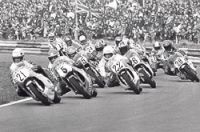Back to the future…
Author: site admin
Category: MotoGP
This past weekend the FIM announced some rule changes for the MotoGP class which will take affect for the 2007 season. While none of the changes were shocking one of them does have me a bit puzzled. Specifically, they have announced that the engine displacement limitation for the MotoGP class will be changed from 990cc to 800cc.
This isn’t really something new though it does have a different face now than it originally wore. Back in the 1970s the FIM actually had a separate world championship race series from the then 500cc two-stroke GP class which ran 750cc machines. Not exactly 800cc but pretty damn close. The class was known as the Formula 750 World Championship and it ran for six years from 1973 to 1979. It was dominated by the Yamaha TZ750, though Suzuki and Kawasaki also raced in the series.
What does a 750cc two-stroke class have in common with the newly proposed 800cc four-stroke class you might ask? Good question and an excellent segue… The comparison isn’t so much between the two classes as it is an example of why the FIM may not be achieving what they think they are achieving. Specifically, they are hoping that reducing the engine displacement of the MotoGP bikes will reduce their speed (at Mugello this past weekend they were topping out around 220 mph on the straight) and thus increase safety. This is not unlike the AMA continually trying to change their premier class to be a 600cc Superbike series (Formula Xtreme) rather than the current 1000cc Superbike class. What I think that the old Formula 750 series indicates is that engine displacement alone doesn’t dictate horsepower.
At the same time that the big TZ750s were tearing up European tracks with their 130hp, the premier GP series was the 500 GP. Yamaha, Honda, Suzuki and Kawasaki were all going head-to-head in that Grand Prix series which ran simultaneously with the F750 series and involved many of the same riders. What is surprising is that the high-tech 500cc Grand Prix bikes like Yamaha’s TZ500s were making…around 120hp. It was in fact a limitation of the tires, frames and tracks of the time that limited the power, not the engine displacement.
I believe that the FIM is overlooking this simple fact…In two years, if not already, Honda and Yamaha will have 800cc engines that produce the same power as the current MotoGP bikes. In fact, the power increases over the past two years have been attributed to three things: 1) the continual one-ups-manship between Honda, Yamaha and Ducati steadily driving each other to unleash more and more power 2) enhanced electronics that help the riders get that power to the ground and finally, 3) Michelin, Bridgestone and Dunlop’s ability to make tires that can handle that power. Those same issues will be what determines the power of the MotoGP bikes in 2007, not some seemingly arbitrary decrease in engine displacement. What’s more, I think continually changing the rules is going to hurt the smaller manufacturers like KTM/Proton and WCM/Blata. They can’t change their engineering plans that quickly and each re-design costs them dearly in capital expenditure and time. It may also prevent new competitors like BMW or FPR from joining the fray if they think they will have to continually redesign their motor. The FIM can’t afford to make rules that continue to decrease the number of competitors in the MotoGP series.
Besides, I believe that the best approach to limiting power is already in place. Rules which restrict engines to normal aspiration, minimum weight rules and a limit on how much fuel a bike can carry during the race. Not only does the 21 liter fuel limitation impose a limit on horsepower it still leaves plenty of room for innovation among the manufacturers on how to achieve the necessary fuel economy. Honda and Yamaha have slowed their horsepower increases while Ducati has instead opted to build new electronics that try to conserve fuel at key moments like when braking or downshifting while continuing to increase peak power. Both approaches get to the same destination but get there two different ways. That is the very core of a prototype race series’ philosophy.
Then again, this rule could suddenly bring Suzuki from floundering to flourishing. They are the only manufacturer making a 750cc sport bike now, so they can just quit producing it, g ive it a cylinder bore and declare it a prototype race bike. If its as good as the GSXR1000, it may be a better starting point for a GP bike than the current GSV-R… Watching a Superbike spec GSXR750 race again really would be going back to the future!
[image from the Motorcycle Hall of Fame Museum web site.]




Nobody has left a comment!